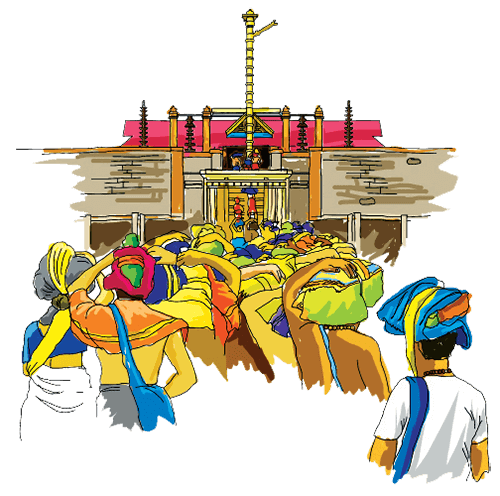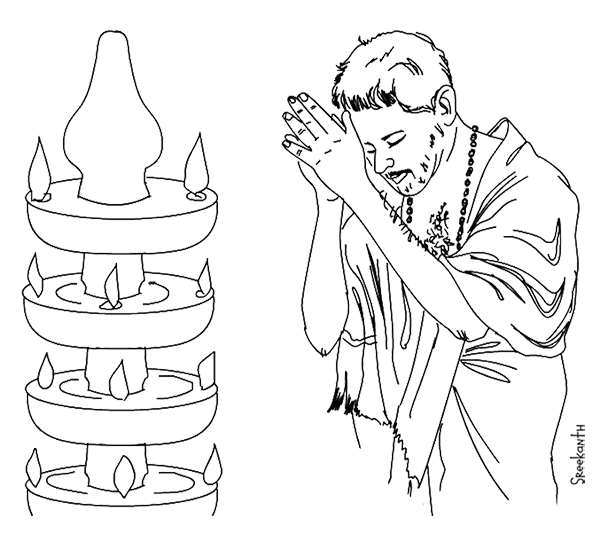The Sree Dharma Sastha Temple at Sabarimala evokes intense devotion among Ayyappa devotees. Onmanorama takes a look at the fascinating origins, unique traditions and the much-storied barefoot trip to the abode of Lord Ayyappa.
The Sree Dharma Sastha Temple at Sabarimala evokes intense devotion among Ayyappa devotees. Onmanorama takes a look at the fascinating origins, unique traditions and the much-storied barefoot trip to the abode of Lord Ayyappa.


The legend of Ayyappa is a mixture of fact and fiction. The legend says Ayyappa was the adopted son of then Pandalam King Raja Rajasekhara. As the king had no heir to his throne, he prayed ceaselessly to Lord Shiva for a child.
On one of his hunting trips to the forests near River Pampa, the king heard the wailing of an infant. Astounded, he followed the sounds and came upon a beautiful child. The king stood there, perplexed, and longed to take the child to his palace.
Whilst the king took the child, a mendicant appeared and instructed him to take the infant to his palace. The stranger assured him that the child would mitigate his dynasty's sufferings and that when the boy turned twelve Rajashekhara would be aware of his divinity.
As the child was wearing a bell strung around his neck, the king named him 'Manikandan', the bell-throated one. The legend says Manikandan, the future Ayyappa, grew in Pandalam as a prince of the kingdom. He was intelligent and mastered martial arts. He won many battles and brought glory and prosperity to the land.
The king wanted Ayyappa to be his heir, but the boy told him that he wished to take up a life of penance. As the heartbroken king pleaded with him not to abandon his father and subjects, Ayyappa granted him a wish. He allowed his father to visit him every year at his forest abode, and see him the way he had desired. So three days before Makaravilakku, which corresponds to Makar Sankranti, when the brahminy kite (Krishna Parunthu) hovers over the Pandalam palace, the king travelled by foot along a rocky dense forest path up the hills to his son's abode.
He took along with him in a palanquin a box filled with ornaments that he would have loved to see glittering on his son as he sat on the throne. Right down to this day, a member of the Pandalam royal family takes the 90 km three-day arduous trek up the hills with the royal ornaments in a palanquin. It is the difficult journey a father undertakes to get a glimpse of his beloved son. It is with the same devotion and prayer, every devotee takes the journey to Sabarimala to see Lord Ayyappa.
Although this is the popular version of the story about the Lord Ayyappa's life, there are many versions like the one that says Ayyappa was a tribal boy in the forest region.
The descendants of Mala Araya tribes, who once lived on the 18 hills surrounding the forest, however, say the boy was born to the childless couple Kandan and Karuthamma from their community after they took a 41-day penance on the advice of a tribal priest, Koorman. He was called Manikandan or Junior Kandan because he was Kandan's son, and not because he had a 'mani' (bell) around his neck.
Read More...

A popular myth says Lord Ayyappa was born out of the union of Lord Shiva and Lord Vishnu when the latter was in the Mohini form. Lord Vishnu took the form of Mohini to destroy the deadly demon Bhasmasur and acquire the elixir for the gods during the great churning of oceans. Legend has it that Lord Shiva got swayed by the charm of Mohini. Their offspring was adopted by Pandalam king and he grew like a prince in the palace.
While Lord Ayyappa was still a minor, a lady demon, 'Mahishi', had created havoc down south. She had got a boon from gods that she could only be defeated by the son born out of the union of Lord Shiva and Lord Vishnu. As it happened, Lord Ayyappa later defeated her in a battle.
By giving salvation to 'Mahishi', Ayyappan set his subjects free from her atrocities. And thus, he is considered as the dispeller of sorrows by his devotees. Dharma Shashta is the deity of Sabarimala. Legend also says Lord Ayyappa dissolved into Dharma Shastha.

The philosophy connected to Lord Ayyappa is deep rooted in Hindu philosophy 'Ahambrahmasmi'. The sacred words displayed on the temple 'Tatvamasi' (Thou art that) also means the same. It shows the oneness of the god with the devotee itself.
At the Sabarimala temple, everyone is an Ayyappan or Malikappurathamma, who is a goddess worshipped at a minor shrine at Sabarimala. Every man who comes to Ayyappan's 'Sannidhanam' by taking the penance is called 'Ayyappa' and women are called 'Malikappurathamma'.
It is believed that by taking the strict penance and the journey, one becomes the Ayyappa himself. It is for this salvation that millions visit the Sabarimala every year.


A pilgrimage to Sabarimala is not just one of piety and devotion. It is one of the most arduous treks that will test your endurance. There are customs and traditions to adhere to; rites and rituals that have to be observed. The rites have to be performed as per tradition to complete a proper pilgrimage, which starts at the end of 41 days of abstinence.

It is the basis for devotion. The Sanatana Dharma, which is based on the Vedic traditions, states that man (jeevaatma) seeks the union with God (paramaatma). This is the ultimate purpose of human life. The pilgrimage to Sabarimala is also to attain this.
There are several pathways to God. These include the Raja Yoga, Bhakti Yoga, Karma Yoga, and Gnana Yoga. The 'Mandala Vratham' falls under the Bhakti Yoga. Then again, the ritual also uses elements from other yogic pathways as well. The aim of the 'vratham' is to bring out the divinity in human beings through devotion to the lord. In observing the 'Mandala Vratham' one is expected to love everyone as they would love their Lord, be peaceful, truthful, righteousness and of course non-violent.
By observing the 'vratham' one tries to develop a sense of control from within. In essence, the 'vratham' is a 'dress rehearsal' that prepares us for the union with God by surrendering our thoughts, words, and deeds and leading an austere life. The austerities are all focussed on renouncing the seven causes of pain.
The 'vratham' is initiated with the invocation of God through the adornment of the Thulasi rosaries. Lord Ayyappa is called Manikandan as he was found in the forest as a baby with a necklace with a bell around his neck. The Mudra rosary symbolises the beginning of the 'vratham.' The Mudra rosary is removed when the 'vratham' concludes after a period of 41 days.
Read More...
The pilgrimage season is rife with calls by devotees that seem to repeatedly echo the submission of the seeker to the Supreme. All paths lead to the abode of Swamy Ayyappa and the resolve to visit him is enough to brave the bitter cold and the toughest of terrain. For the devotee, the means and end is Ayyappa, the redeemer of ignorance. Each swamy (ascetic) carries a bundle on his/her head, which is full of oblations to the lord and signifies renunciation and sacrifice. ('Swamy' means 'he who is one with the Self'). Though there are several routes to reach Sabarimala, the one through Erumeli is the most popular. Erumeli, it is believed, is the place where Ayyappa defeated the demon Mahishi. Here one can see 'Rudirakulam,' the pool in which Mahishi breathed her last.

At Erumeli the pilgrims offer prayers to Lord Ayyappa's lieutenant Vavar, who was a Muslim, at a mosque, which is right next to a temple dedicated to Ayyappa himself. Before leaving Erumeli, pilgrims perform 'Petta Thullal', a warrior dance. They smear their bodies with colours and dance wildly, sporting replicas of ancient weapons like the mace.
This ritual prepares them mentally for the journey through the forest. In the olden days, people used to trek about 60 km from Erumeli through the jungles, covering forest zones like Kalaketti, Azhutha, Kallidamkunnu, Mukkuzhi, Puthussery, Adivaram, Karimala, Valiyanavattam, Cheriyanavattam, before reaching Pamba. The rocky trail over the hills takes them through thorns and past wild animals, but the walk purifies both the body and the mind as it is close to nature.
Read More...

There is an incessant flow of devotees, purified by the observance of 41-day penance, to Sabarimala. Once the sacred rosary chain is worn, the pilgrim becomes one with the lord. Therefore, sanctity of the penance is of prime most importance. The penance for pilgrimage should start on the first day of Malayalam month 'Vrishchikam' and those who plan to go earlier should start the penance accordingly.
First-timers should observe 51 days of penance as against the 41 to be observed by senior pilgrims. All men who observe the mandatory penance can get darashan, but women between the age of 10 and 50 were not traditionally permitted inside the temple.
As a symbol of observing penance, one has to wear the chain with lord Ayyappa's image on the pendant. The chain has to be first sanctified at a temple or by a senior pilgrim before it is worn. The best days to wear the chain are Saturdays and Uthram - the birth star of lord Ayyappa. The chain may be made of basil (Tulsi) or Rudraksha. Once the penance begins, one has to take bath twice a day and observe strict celibacy.

"Jnana mudram shasthra mudram, guru mudram namamyaham
Vana mudram shuddha mudram rudra mudram namamyaham
Shanta mudram satya mudram vrata mudram namamyaham
Sabaryashrama satyena mudram paathu sadaapimem
Gurudakshinaya purvam tasyanugraha karane
Sharanagata mudrakhyam tanmudram dharayamyaham
Sabraya chala mudrayayai namastubhyam namo namah"

I offer my salutations to the symbol of wisdom, the learned texts, the preceptor, the forest and purity. I offer my salutations to the symbol of peace, truth, penance; may the Truth of Sabari's hermitage ever protect this symbol. After seeking and securing the compassionate grace and blessings of my preceptor, O Lord, I will wear this symbol of my complete surrender seeking refuge in You. I offer my salutation to the symbol of pure intellect, the celestial beings, and auspiciousness. O symbol of the Sabari Hill, I offer my salutations to you again and again.
Read More...